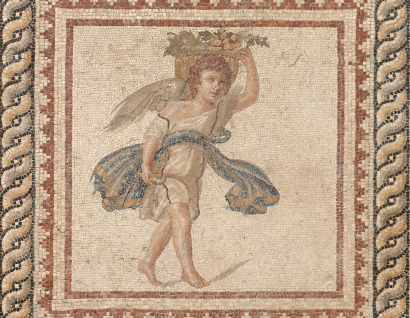
- Type: Classroom Activity
- Collection: Ancient Art
- Culture/Region: Rome
- Subject Area: History and Social Science, Visual Arts
- Grade Level: K-5
Object Information
Romans often decorated their public buildings, villas, and houses with mosaics—pictures or patterns made from small pieces of stone and glass called tesserae (tes’-er-ray). To make these mosaics, artists first created a foundation (slightly below ground level) with rocks and mortar and then poured wet cement over this mixture. Next they placed the tesserae on the cement to create a design or a picture, using different colors, materials, and sizes to achieve the effects of a painting and a more naturalistic image. Here, for instance, glass tesserae were used to add highlights and emphasize the piled-up bounty of the harvest in the basket.
This mosaic panel is part of a larger continuous composition illustrating the four seasons. The seasons are personified as erotes (er-o’-tees), small boys with wings who were the mischievous companions of Eros. (Eros and his mother, Aphrodite, the Greek god and goddess of love, were known in Rome as Cupid and Venus.) Erotes were often shown in a variety of costumes; the one in this panel represents the fall season and wears a tunic with a mantle around his waist. He carries a basket of fruit on his shoulders and a pruning knife in his right hand to harvest fall fruits such as apples and grapes.
Although some mosaics were applied to walls and even ceilings, most were placed on floors, serving as part of the architecture as well as the decoration in Roman buildings. The four seasons mosaic was created around the mid to late third century and decorated the corridor next to two cubicula, or bedrooms, of a house. On the floor of the triclinium, or dining room, was another mosaic showing a drinking competition between Dionysus and Hercules This “House of the Drinking Contest,” as it was accordingly named, was in Seleucia, the port of the city of Antioch, capital of the Roman province of Syria. Antioch was one of the largest cities of the Roman Empire, strategically located between trade routes from Asia Minor to Europe. Many different goods were traded at Antioch including spices. When this site (in present-day Turkey) was excavated by archaeologists in the 1930s, some of the discoveries remained in Turkey while others were sent to various museums and universities that helped fund the excavation.
Concept
Students will be introduced to the ancient Roman art of mosaics by studying the Section of a Floor Mosaic Depicting Fall. They will learn about how mosaics were made and used in Roman houses. They will also learn about the ancient Roman city of Antioch and its importance in the Roman Empire.
Map
Have students view a detailed map of the Roman Empire and locate the city of Antioch. It was located in a prime spot for trade between the lands of Asia Minor and those of the rest of the European continent. Students will discuss the types of things that might have been traded in the Roman Empire including Antioch.
Download File